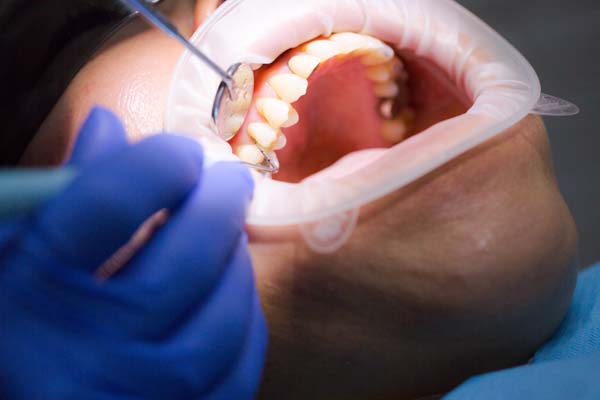Periodontics Los Angeles, CA
Periodontics refers to a dental field that focuses primarily on diseases and conditions affecting the gums and supporting tooth structures. Periodontists provide services in diagnosing, preventing, and treating patients with periodontal, gum, and other oral diseases. Periodontal treatment can greatly improve symptoms, reduce pain, and prevent further dental complications from arising.
Periodontal treatment is available at Dr. Robert B Tamaki, DDS in Los Angeles and the surrounding area. We can help curb symptoms and keep oral diseases under control. Call us today at (310) 402-0156 to schedule an appointment or learn more about our services.
Signs Indicating Need for Periodontal Treatment
The most common cause of periodontal and gum disease is plaque buildup, often the result of poor oral hygiene habits such as inadequate brushing, flossing, and rinsing. Plaque eventually leads to tartar, a substance that eats away enamel and causes inflammation and infection. Tartar can also reach below the gum line, making the teeth harder to clean and maintain.
Other common risk factors include diabetes, hormonal changes in girls and women, medications that decrease saliva flow, certain illnesses, and genetics. According to the CDC, signs or symptoms related to periodontal disease include:
- Bad breath or bad taste that will not go away
- Red or swollen gums
- Tender or bleeding gums
- Painful chewing
- Loose teeth
- Sensitive teeth
- Gums that have pulled away from your teeth
- Any change in the way your teeth fit together when you bite
- Any change in the fit of partial dentures
“The most common cause of periodontal and gum disease is plaque buildup, often the result of poor oral hygiene habits such as inadequate brushing, flossing, and rinsing.”
Hard Tissue/Osseous Procedures
An osseous procedure is a periodontal treatment that reduces or completely eliminates bacteria living in pockets underneath the gums. Healthline explains that during the procedure, a surgeon cuts back the patient's gums, removes the bacteria, and repairs damaged bone. Hard tissue procedures primarily curb the progression of gum disease but can also involve treating the enamel, dentin, and cementum.
In both hard tissue and osseous procedures, the primary goal is to remove bacteria from the pockets to prevent the spread of infection and disease. With advancements in modern dental technology, these procedures can be done using a laser that burns bacteria without coming close to the nerves, roots, or bone. Once the gums are reattached and sewn, they naturally heal and cling onto the tooth, slightly tighter than they were before.
“In both hard tissue and osseous procedures, the primary goal is to remove bacteria from the pockets to prevent the spread of infection and disease.”
Periodontal Disease
Gingivitis, the mildest form of periodontal disease, can cause the gums to bleed easily and become red and swollen. It is typically reversible with professional treatment and good oral hygiene. According to the American Academy of Periodontology, untreated gingivitis can easily develop into periodontitis.
Receding gums are common in the early stages of periodontitis, causing small pockets to form between the gums and the teeth. Moderate periodontal disease may also bring about bleeding and pain around the teeth, along with further gum recession. Teeth may also lose bone support and become loose. Finally, persons with advanced periodontal disease will see the connective tissue holding the teeth in place deteriorating, leading to tooth loss.
“According to the American Academy of Periodontology, untreated gingivitis can easily develop into periodontitis.”
Check out what others are saying about our dental services on Yelp: Periodontics in Los Angeles, CA
Preventing Periodontal Disease
There are a variety of ways patients can prevent the development and progression of periodontal disease. First and foremost, practicing adequate oral hygiene habits is essential for proper oral care and function. The American Academy of Periodontology suggests doing the following to prevent periodontal disease:
- Brush your teeth: Brushing after meals can help remove food debris and plaque trapped between the teeth and gums; especially if one thoroughly brushes the tongue.
- Floss: Flossing at least once a day can help remove food particles and plaque between teeth and along the gum line that your toothbrush cannot quite reach.
- Swish with mouthwash: Using a mouthwash helps reduce plaque and can remove remaining food particles that brushing and flossing missed.
- Know your risk: Age, smoking, diet, and genetics can all increase the risk for periodontal disease. If at increased risk, be sure to talk with the dental professional.
- See a periodontist: Get an annual comprehensive periodontal evaluation (CPE) from a dental professional. A CPE looks at the teeth, plaque level, gums, bite, bone structure, and other risk factors for periodontal disease. Identifying symptoms of gum disease early is key to protecting the teeth and gums.
“First and foremost, practicing adequate oral hygiene habits is essential for proper oral care and function.”
Questions Answered on This Page
Q. What are some signs that indicate a person may have periodontal disease?
Q. What are hard tissue and osseous procedures?
Q. What happens as periodontal disease progresses?
Q. What happens during periodontal surgery?
People Also Ask
Q. What are the signs of gum disease?
Q. Why is stopping infection from spreading important?
Periodontal Surgery
Patients with advanced periodontal disease may require periodontal surgery. This surgery involves removing the bacteria from beneath the gums, facilitating the cleaning of the teeth, reshaping the bones supporting the teeth, and helping prevent future gum damage. Depending on the patient's case, flap surgery, bone grafting, guided tissue regeneration, soft tissue grafts, or special proteins may be necessary.
In flap surgery, Dr. Robert B Tamaki, DDS makes a small incision into the gum and lifts back a part of tissue to remove tartar and bacteria from the tooth and underneath the gums. In contrast, bone grafting repairs any damage done to the bone surrounding the tooth root. Similarly, guided tissue regeneration stimulates bone regrowth by placing a small piece of material between the gum tissue and the bone. Soft tissue grafts help restore lost tissue, while special proteins can encourage healthy bone and tissue regeneration.
“Depending on the patient’s case, flap surgery, bone grafting, guided tissue regeneration, soft tissue grafts, or special proteins may be necessary.”
Frequently Asked Questions About Periodontics
Q. Will my insurance cover periodontal treatment?
A. While the answer to this question varies on a case-by-case basis, most dental insurance policies tend to cover periodontal treatment. For the most accurate possible answer, speak to your carrier directly. Do not forget to bring your medical and dental benefit information and cards to your appointment.
Q. Can my kids develop periodontal disease?
A. It is rare for children to develop periodontal disease, though it does sometimes occur (particularly in adolescents). In any case, it is essential for patients of all ages to learn the importance of keeping a good oral hygiene routine to keep periodontal disease at bay in the future.
Q. Are there any consequences to missing teeth?
A. Yes, missing teeth are more than just an aesthetic issue. The teeth surrounding the gap may shift, and it may be more difficult for you to chew your food properly or even affect the way you speak. As such, it is crucial to address missing teeth as soon as possible.
Q. What can I expect from my first periodontal examination?
A. During your first periodontal examination, you will undergo a thorough physical examination of your mouth. Along with other things, Dr. Robert B Tamaki, DDS will check the health of your gums, the status of your teeth, and the alignment of your bite. We may also perform certain imaging tests to make an accurate official diagnosis.
Q. What else can periodontists do?
A. While most periodontists spend most of their time diagnosing and treating gum disease, they can also perform various other procedures. These include placing dental implants when natural teeth cannot be saved, monitoring implants, correcting gum recession, and coordinating comprehensive dental care along with your dentist.
Periodontic Terminology
Call Us Today
Periodontal treatments can help prevent, curb, or treat periodontal disease and help you maintain a healthy oral cavity. Call us today at 310-402-0156 to schedule an appointment or learn more about our services.
Helpful Related Links
- American Dental Association (ADA). Glossary of Dental Clinical Terms. 2024
- American Academy of Cosmetic Dentistry® (AACD). Home Page. 2024
- WebMD. WebMD’s Oral Care Guide. 2024
About our business, license, and website security
- Dr. Robert B Tamaki, DDS was established in 1985.
- We accept the following payment methods: Cash, CareCredit, Check, MasterCard, and Visa
- We serve patients from the following counties: Los Angeles County
- We serve patients from the following cities: Los Angeles, Santa Monica, Venice, Marina Del Rey, Redondo Beach, Hermosa Beach, Manhattan Beach, and Westchester
- CA (License #DDO-33386). View License Information and Specifics
- National Provider Identifier Database (1568559011). View NPI Registry Information
- Healthgrades. View Background Information and Reviews
- Norton Safe Web. View Details
- Trend Micro Site Safety Center. View Details
Back to top of Periodontics











